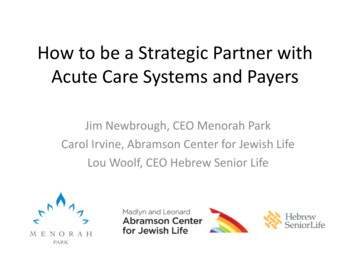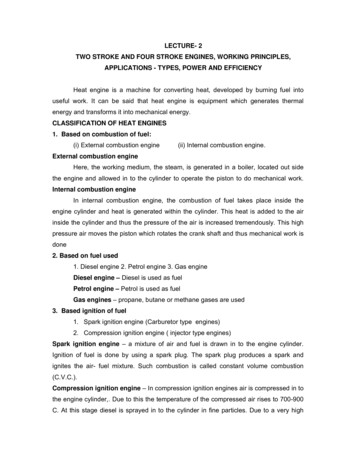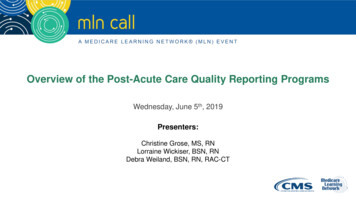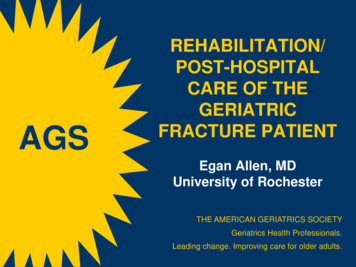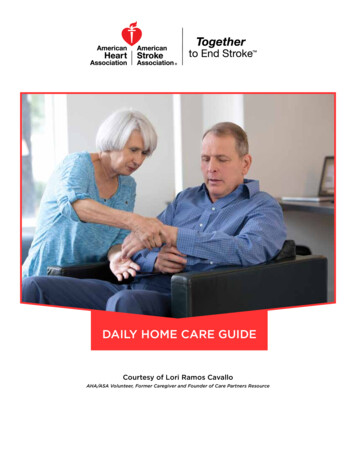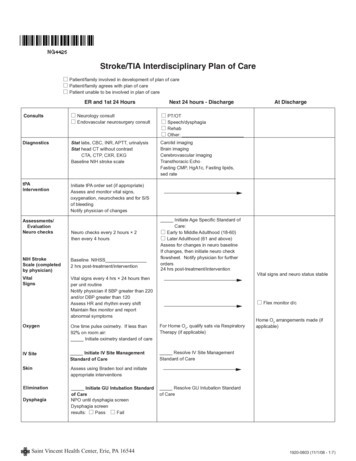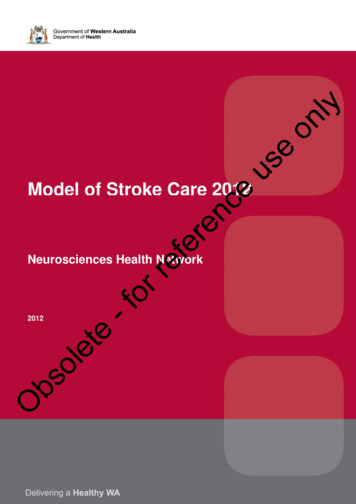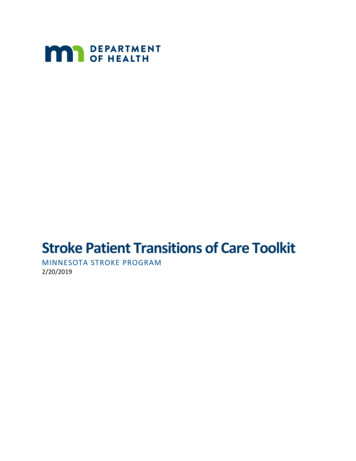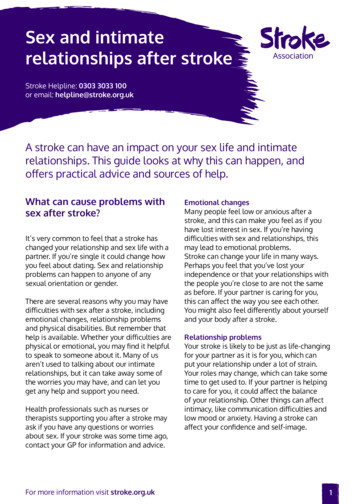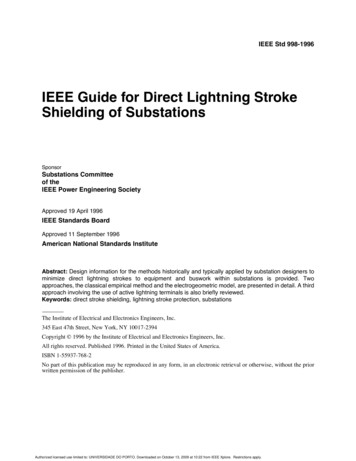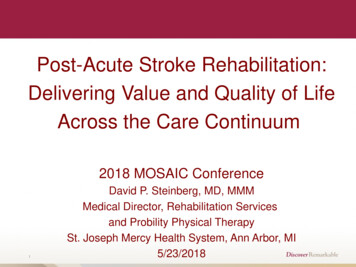
Transcription
Post-Acute Stroke Rehabilitation:Delivering Value and Quality of LifeAcross the Care Continuum2018 MOSAIC Conference1David P. Steinberg, MD, MMMMedical Director, Rehabilitation Servicesand Probility Physical TherapySt. Joseph Mercy Health System, Ann Arbor, MI5/23/2018
Disclosures:The content of this presentation is mine alone and reflectspersonal opinion, bias, and conjecture.I have no commercial interests to disclose.
Post-discharge continuum of care options for stroke rehabilitationpatients are often absent or confusing for patients, care givers,and providers. Community resources that effectively addresspatients’ needs along the continuum of care can improve qualityof life and functional recovery.Objective: Be able to describe appropriate elements in thepost-discharge continuum of care for stroke rehabilitation patients.35/31/2018Proprietary & Confidential
What is the “Triple Aim” anyway?Basketball Shoot, Dribble, or PassGreek mythology Zeus, Poseidon, HadesStooges Curly, Mo, Larry
What is the “Triple Aim” anyway?Health care reform Better Health, Better Care, Lower CostStroke Patient Compensate, Restore, Enhance Mind, Body, Spirit Mobility, Self-Care, Social (Relationships, work)Care System Patient, Family, Caregivers Doctors, Nurses, Therapists (PT, OT, SLP, TR, SW) EMS, Acute, Post-Acute IRF, SAR, Outpatient PT, OT, Speech Tx
Health Care Reform65/31/2018Proprietary & Confidential
“Volume to Value” reimbursement shift1965: Medicare and Medicaid, Reimbursement of Costs 2%.Growth rate 13% per year.1983: DRG’s, moved from retrospective payments to prospectivepayments. Growth slowed from 9.9% to 5% per year.2010: Patient Protection and Affordable Care Act (PPACA)2015: Medicare Access and CHIP Reauthorization Act (MACRA)2018: ACO’s, Bundled payments, Advanced Payment models
It’s working which means more to come!
System Changes1. Community and population health management structures:ACO’s, CIN’s, APM’s, PCMH, Medicare Advantage Programs2. Data analytics tools (risk, outcomes, cost-benefit, value): Readmission rates FIM efficiency Costing3. Prospective utilization reviews– Waiting by the phone .“Denied!” “Justification? “NO!” “Why?”4. Growing gap between expectations and resources
Impacts on Rehab Shorter lengths of stay and higher acuityNeed to demonstrate quality/outcomesFewer resources (tighter margins, FTE and Capital squeeze)Prior authorizations (more delays and denials)Concurrent reviews and 3rd party benefit administratorsMounting pressure to move patients to lower levels of careBundled payments and lower reimbursementsShifting costs to patients with higher copaysGrowing consumerism/retail mindsetNarrow networks, ACO’s, CIN’sRedirecting patients from IPR to SAR/ECF risks increasedreadmission rates, higher complications, reduced functionalrecovery, and lower quality of life.
Opportunities Integrate Subacute Rehab (SNF) and Home Care modelsExpand and leverage Telemedicine and Navigator supportEmbrace consumerism and value (price/cost/value transparency)Focus on “Patient-centered Care” and Population HealthEmphasize restoration over compensation(e.g. Miami Project, Shirley Ryan Ability Lab, Utah NeilsenRehab Center)Technological advancements: Predictive analytics with machinelearning and A.I.; Robotics; Stem Cells; Assistive and Adaptivetechnologies; Neural interfaces; VR and gaming apps
Historical Perspective Medicare/Medicaid legislation passes in 1965 Amended in 1982 by TEFRA act, which limited payment toIRF’s, while SNF remained cost-based Both programs excluded from hospital DRG payment system In 1997 the HCFA/CMS published criteria for Prospective Payment Systems (PPS) for IRF’s and SNF’s In 1998 the Final Rule for SNF PPS was published In 2001 the Final Rule for IRF’s was published125/31/2018Proprietary & Confidential
CMS 8 Criteria for IRF1.2.3.4.5.6.7.8.Close medical supervision by physician with specialized trainingTwenty-four hour rehabilitation nursingRelatively intense level of rehabilitation services (3 hour rule)Multidisciplinary team approachCoordinated program of careSignificant practical improvement (is anticipated)Realistic goalsLength of rehabilitation program (is appropriate)“60% rule” for maintaining “exempt “status“Medical Necessity” rules – Interqual, etc.
Definitions of Skilled and IRF CareDefinition of Rehabilitation CareThe Inpatient Rehabilitation Facility (IRF) provides services to aninpatient who needs a relatively intense rehabilitation program thatrequires a multidisciplinary coordinated team approach to upgradehis functional ability.Definition of the Skilled Nursing Care:The SNF provides intermittent and/or daily skilled care services.These services are provided by professional nurses and/ orrehabilitation professionals.
Head-to-head Comparison
165/31/2018Proprietary & Confidential
Compare Acute IRF vs Subacute SAR 0.4% vs 4% mortalityLower Readmission ratesShorter Lengths of Stays (13.1 vs. 27)More likely to discharge homeMore costly up front ( 17,000 vs 11,000)Access to botulinum toxin, medical specialists, psychologyand neuropsychology Greater patient-family satisfaction Discharge experience less favorable for IRF SAR Home
185/31/2018Proprietary & Confidential
AHA/ASA press release, “Inpatient rehab recommended over nursing homes for Stroke rehab,” issuedMay 4, 2017 (newsroom.heart.org)“Guidelines for Adult Stroke Rehabilitation and Recovery,” issued May, 2016 (stroke.ahajournals.org)
Proprietary & Confidential
Creative Post-Acute Resources Integrated Continuum:Acute care IRF SAR HC OP Fitness Support “Stroke Rehab Care Navigation Team”:PM&R Physician and APP/RN Telemedicine: Pharmacist, nurse, doctor, dietician, etc. Patient Centered Medical Home Neighborhoods:PCP-Specialists-Care Navigators “Intensive Cardiac Rehab”: intensive risk factor reductionwith plant-based nutrition, didactics, exercise, coaching
Examples Speech and Hearing Clinic at Eastern Michigan University EMU Psychology Clinic Aphasia Community Friendship Center University of Michigan Aphasia Program WCC Health and Fitness Center “Next Steps” Ann Arbor Stroke Survivor and Caregiver Support Group225/31/2018Proprietary & Confidential
Associates in PM&R235/31/2018Proprietary & Confidential
Thanks!
Speech and Hearing Clinic at Eastern Michigan University EMU Psychology Clinic Aphasia Community Friendship Center University of Michigan Aphasia Program WCC Health and Fitness Center “Next Steps” A
